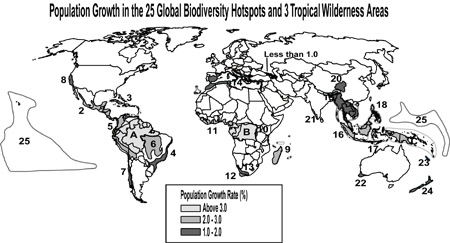Biodiversity and population growth
How important is population growth to current global biodiversity loss? Although there is no credible numerical answer to that question, the bulk of the evidence suggests that population growth is and has been an important underlying cause of biodiversity loss. Perhaps most worrisome is that some of the most rapid human population growth is occurring in the vicinity of some of the world’s biologically richest yet most vulnerable habitats.
We recently examined rates of population growth (including migration) and density in 25 “biodiversity hotspots,” areas identified by Conservation International as especially rich in endemic species but which have experienced dramatic reductions in the amount of original vegetation remaining within their boundaries. Nearly one-fifth of humanity (more than 1.1 billion people) lives within the hotspot boundaries, despite the fact they enclose only one-eighth of the planet’s habitable land area, according to 1995 population data. In all, 16 of the 25 hotspots are more densely populated than the world as a whole, and 19 have population growth rates faster than the world average. In addition, more than 75 million people, or 1.3 percent of the world’s population, now live within the three major tropical wilderness areas (Upper Amazonia and Guyana Shield in South America, the Congo River Basin of central Africa, and New Guinea and adjacent Melanesia).
The 25 Global Hotspots
| Hotspot Area (thousands of sq. km.) | Human Population,1995 (thousands) | Population Density, 1995 (per sq. km.) | Extent of Population Growth Rate, 1995-2000 (percent per year) | Original Vegetation (thousands of sq. km.) | Original Extent Remaining Intact | Original Extent Protected | ||
|---|---|---|---|---|---|---|---|---|
| 1 | Tropical Andes | 1415 | 57,920 | 40 | 2.8 | 1258 | 25% | 6.3% |
| 2 | Mesoamerica | 1099 | 61,060 | 56 | 2.2 | 1155 | 20% | 12.0% |
| 3 | Caribbean | 264 | 38,780 | 136 | 1.2 | 264 | 11% | 15.5% |
| 4 | Atlantic Forest Region | 824 | 65,050 | 79 | 1.7 | 1228 | 8% | 2.7% |
| 5 | Chocó-Darién-Western Ecuador | 134 | 5,930 | 44 | 3.2 | 261 | 24% | 6.3% |
| 6 | Brazilian Cerrado | 2160 | 14,370 | 7 | 2.4 | 1783 | 20% | 1.2% |
| 7 | Central Chile | 320 | 9,710 | 29 | 1.4 | 300 | 30% | 3.0% |
| 8 | California Floristic Province | 236 | 25,360 | 108 | 1.2 | 324 | 25% | 9.7% |
| 9 | Madagascar and Indian Ocean Islands | 587 | 15,450 | 26 | 2.7 | 594 | 10% | 1.9% |
| 10 | Eastern Arc Mts. & Coastal Forests | 142 | 7,070 | 50 | 2.2 | 30 | 7% | 17.0% |
| 11 | Guinean Forests of West Africa | 660 | 68,290 | 104 | 2.7 | 1265 | 10% | 5.6% |
| 12 | Cape Floristic Province | 82 | 3,480 | 42 | 2.0 | 74 | 24% | 19.0% |
| 13 | Succulent Karoo | 193 | 460 | 3 | 1.9 | 112 | 27% | 2.1% |
| 14 | Mediterranean | 1556 | 174,460 | 111 | 1.3 | 2362 | 5% | 1.8% |
| 15 | Caucasus | 184 | 13,940 | 76 | -0 3 | 500 | 10% | 2.8% |
| 16 | Sundaland | 1500 | 180,490 | 121 | 2.1 | 1600 | 8% | 5.6% |
| 17 | Wallacea | 341 | 18,260 | 54 | 1.9 | 347 | 15% | 5.9% |
| 18 | Philippines | 293 | 61,790 | 198 | 2.1 | 301 | 8% | 1.3% |
| 19 | Indo-Burma | 2313 | 224,920 | 98 | 1.5 | 2060 | 5% | 5.2% |
| 20 | Mountains of South-Central China | 469 | 12,830 | 25 | 1.5 | 800 | 8% | 2.1% |
| 21 | Western Ghats and Sri Lanka | 136 | 46,810 | 341 | 1.4 | 183 | 7% | 10.4% |
| 22 | Southwest Australia | 107 | 1,440 | 13 | 1.7 | 310 | 11% | 10.8% |
| 23 | New Caledonia | 16 | 140 | 8 | 2.1 | 19 | 28% | 2.8% |
| 24 | New Zealand | 260 | 2,740 | 11 | 1.0 | 271 | 22% | 19.2% |
| 25 | Polynesia / Micronesia | 46 | 2,900 | 58 | 1.3 | 46 | 22% | 10.7% |

By 1995, population density (people per square kilometer) in the biodiversity hotspots was almost twice that of the world as a whole, and 16 of the 25 hotspots were more densely populated than the world population density of 42 people per square kilometer. As of 1995, the three major tropical wilderness areas (A, B, C) were still populated at relatively low densities.
Source: Population Action International; data from NCGIA/CIESIN, 1998.

The total population of the 25 hotspots is growing 1.8 percent annually, compared to 1.6 percent for developing countries and 1.3 percent for the world overall. The combined population within the forested wilderness areas (A, B, C) is growing at a rate of 3.1 percent annually–more than twice the world’s average population growth.
Source: Population Action International.
